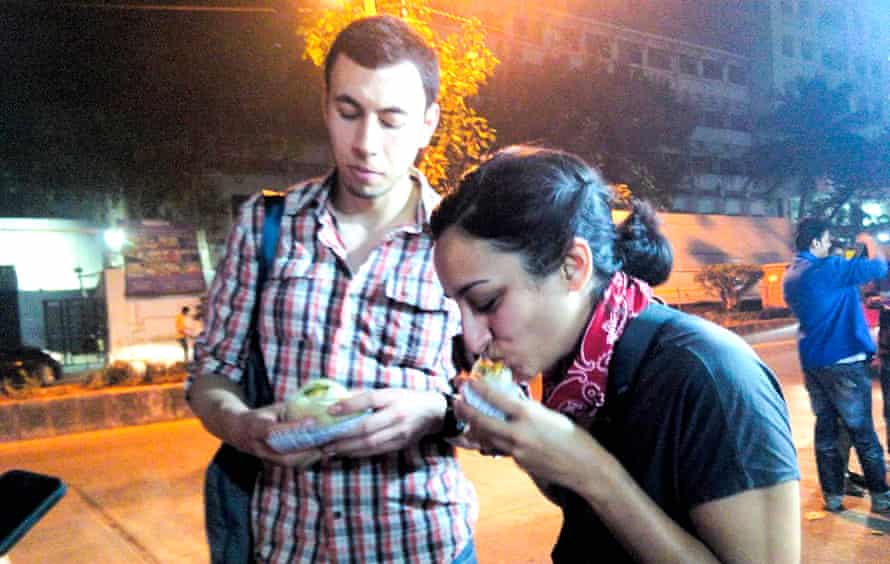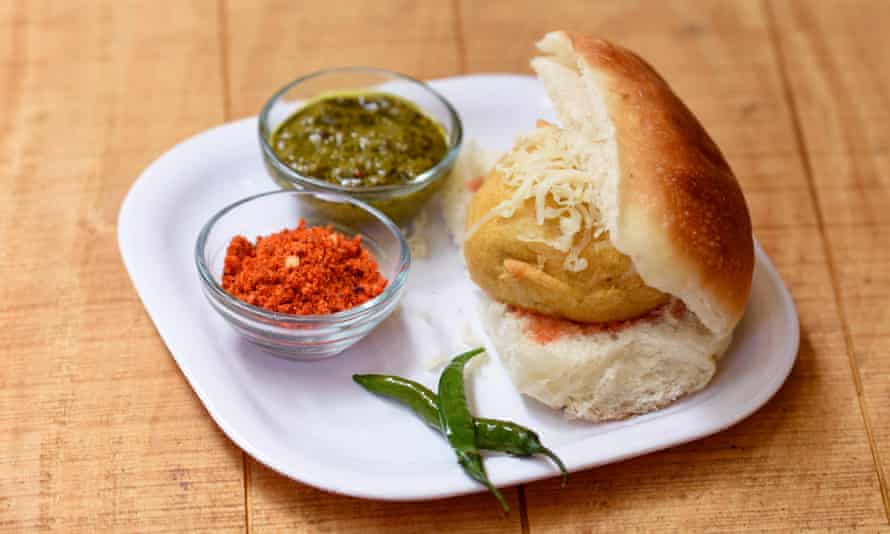Mumbai was the first stop on an eight-month, round-the-world trip I took with my husband in 2014. The longest time I’d spent out of the UK prior to this had been three weeks. I’d only ever visited three places outside Europe, and it took me a whole year to persuade my other half to join me. And our main objective for these months on the road? To eat.
We hurled ourselves in at the deep end, starting in Mumbai. It is so vast and sprawling that it’s hard not to assume the entire country must lie within this city alone. It was at least 10 times as alive and chaotic and exhausting as I’d dared anticipate. Mumbai offers an unrelenting onslaught on all the senses, particularly hearing: the horn honking does not stop.

I knew there would be a kaleidoscope of incredible food in Mumbai, but where would a tourist even begin to begin? To help us distill the city’s eateries down to a handful that could not be missed on a first visit, I connected with three local food bloggers – Sameer, Jahan and Jagruti – and spent a spectacular evening scooting around the city in a rickshaw, grazing on some of the tastiest bites in town.
We scooped up raj kachoris at Elco in the upmarket Bandra district. These are great big puris loaded with yoghurt, chutneys, bean sprouts, chickpeas, potato and fried crispy bits, entirely impossible to eat in one bite.
One of India’s favourite fast foods is the vada – a deep-fried crispy ball or patty. At Prakash in busier Dadar, we stopped for a spread of crunchy sabudana vadas, a mix of soaked tapioca pearls, potato, ground peanuts, chilli, coriander and lemon juice, rolled into balls then fried.
But all my excited anticipation was reserved for vada pav. I’d come to Mumbai well versed on the city’s favourite street food and eager to try what the bloggers deemed the most superior specimens.
Vada pavs are native to Maharashtra, the large western state of which Mumbai is the capital, and sometimes referred to as a Bombay burger. It’s fast, cheap and comes in a bread roll – but I’d have this veggie snack over a burger most days.
The spicy potato balls are coated in gram (chickpea) flour, deep-fried and served with a lick of at least one hot chutney – often a garlicky green one – in a soft bun, with a blistered green chilli for good measure. They are salty, spicy, supremely satisfying and the cheapest thing we had in the city. Thirty rupees (roughly 30p) for two.
You can find vendors slinging these on every street corner in Mumbai and beyond, but only about five stalls do them really well. We had ours in the north-west of the city, from Dhiraj Vada Pav, a few blocks from the beach in Juhu, opposite prestigious Mithibai College. Fresh from the fryer and still too hot to handle, they were a strong contender for the favourite thing to pass my lips during the entire five weeks I spent in India. I think I ate three in a row.
Mumbai’s vada pav sandwich with chutneys

Photograph: Neha Sadaye/Alamy
Makes six
For the green chutney
Fresh mint, small bunch
Coriander, small bunch (including stalks)
1-2 green chillies, roughly chopped
1 tbsp ground almonds
Juice of half a lemon
Salt
For the red chutney
3 tbsp desiccated coconut
1 garlic clove, finely sliced
1-2 tsp chilli powder
Salt
For the vada potato balls
3 potatoes, boiled and mashed
2 inch piece of fresh ginger, grated
4 garlic cloves, minced
1 tbsp sunflower oil
1 tsp mustard seeds
1 tsp turmeric
3 green chillies, finely chopped
1/2 tsp asafoetida
Handful of fresh coriander, finely chopped (including stalks)
Salt
For the batter and frying
150g gram (chickpea) flour
1/4 tsp turmeric
80ml warm water
Salt
Sunflower oil
To serve
Six small soft white rolls
Butter (optional)
Six green finger chillies, deep-fried
First make the chutneys. For the green, combine the mint, coriander, chillies and ground almonds, add some of the lemon juice, and blitz. Keep adding lemon juice until you have a spreadable consistency – it shouldn’t be too wet. You may not need all the lemon juice. Add salt to taste.
For the red chutney, toast the coconut in a dry pan until it turns a nice colour, combine with the garlic, chilli powder and a pinch of salt, then pound using a pestle and mortar. Add a splash of water if needed to loosen the mixture slightly – it should be dry and crumbly. Set both chutneys aside.
To make the potato balls, heat the oil in a frying pan on a medium to high heat. When it’s hot enough for one mustard seed to sizzle, add the rest of the mustard seeds and the asafoetida. When the mustard seeds start popping vigorously, reduce the heat to low to medium and add the ginger, garlic and chillies. Cook for one minute, then add the turmeric and cook for another minute.
Now add the mashed potato and fresh coriander, fully combine and cook for another minute. Add salt to taste. Remove the mashed potato from the pan and set aside to cool.
Weigh the total amount of potato and divide this number by six so you know how much each portion should weigh – mine were about 75g each. Measure out six portions and roll into balls with your hands. Set aside.
To make the batter, combine the gram flour with the turmeric and a pinch of salt. Add the water a little at a time, mixing with a whisk until you have a smooth and fairly thick batter. Set aside.
Fill a heavy-bottomed saucepan with enough sunflower oil to reach halfway up the vada balls. Heat on medium to high. To test if the oil is hot enough, add a little batter. If it sizzles and cooks to a golden colour, it’s ready. First drop in the six finger chillies. When they’ve cooked and blistered, remove and drain on kitchen paper.
Coat each ball in the batter, and gently drop into the hot oil. Turn the ball around in the oil until the whole thing is cooked and golden. Remove with a slotted spoon and drain on kitchen paper. Repeat for all the balls.
To serve, slice each roll in half and butter, if desired. Smear on some green chutney, add a vada ball, some of the dry red chutney and a deep-fried chilli, and devour.
Leyla Kazim is a presenter on BBC Radio 4’s The Food Programme and a digital creator specialising in travel and food. Follow her on social media @thecutlerychronicles and @leylalaa





